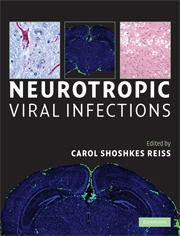Book contents
- Frontmatter
- Contents
- List of contributors
- Foreword
- Preface and acknowledgments
- Section I Introduction: RNA viruses
- Section II Introduction: retroviruses, DNA viruses, and prions
- Section III Introduction: immunity, diagnosis, vector, and beneficial uses of neurotropic viruses
- 14 Innate immunity in viral encephalitis
- 15 Role of Toll-like receptors in neurotropic viral infections
- 16 Neuroendocrine-immune interactions in neurotropic viral infections
- 17 Epidemiology of viral encephalitis
- 18 Pathogen surveillance and discovery
- 19 Clinical management of viral encephalitis
- 20 Influences of arthropod vectors on encephalitic arboviruses
- 21 The role of bats as reservoir hosts of emerging neurological viruses
- 22 Viral oncolysis of glioblastoma
- 23 Viral gene therapy for central nervous system diseases
- Index
- Plate section
- References
21 - The role of bats as reservoir hosts of emerging neurological viruses
from Section III - Introduction: immunity, diagnosis, vector, and beneficial uses of neurotropic viruses
Published online by Cambridge University Press: 22 August 2009
- Frontmatter
- Contents
- List of contributors
- Foreword
- Preface and acknowledgments
- Section I Introduction: RNA viruses
- Section II Introduction: retroviruses, DNA viruses, and prions
- Section III Introduction: immunity, diagnosis, vector, and beneficial uses of neurotropic viruses
- 14 Innate immunity in viral encephalitis
- 15 Role of Toll-like receptors in neurotropic viral infections
- 16 Neuroendocrine-immune interactions in neurotropic viral infections
- 17 Epidemiology of viral encephalitis
- 18 Pathogen surveillance and discovery
- 19 Clinical management of viral encephalitis
- 20 Influences of arthropod vectors on encephalitic arboviruses
- 21 The role of bats as reservoir hosts of emerging neurological viruses
- 22 Viral oncolysis of glioblastoma
- 23 Viral gene therapy for central nervous system diseases
- Index
- Plate section
- References
Summary
Introduction
It is now well-recognized that more than 75% of emerging diseases over the past 2 decades have been zoonoses. Many of these zoonotic viruses have caused neurological disease, especially those emerging during this period in the South-East Asian and Western Pacific regions [1, 2]. Most of the diseases emerging from wildlife have been from bats and rodents. Bats are only second to rodents in terms of mammalian species richness [3] and constitute about 20% of all mammalian species. Thus, with their wide distribution and abundance, it is not surprising that there is growing awareness that bats are the reservoir hosts for a number of these emerging viruses [4, 5, 6, 7] and suspected of being associated with many others on serological grounds. Not only have they been shown to be the reservoir hosts for rabies and related lyssaviruses but also for other human pathogens, or potential pathogens, such as SARS-coronavirus-like viruses [8, 9, 10], Ebola virus [11, 12], Menangle virus [13], and Hendra and Nipah viruses [14, 15, 16]. This brief review looks at the biological features that make bats good reservoir hosts, and the more important neurological viruses associated with bats that are, or have the potential to be, transmitted to humans.
Bats as reservoir hosts: Implications for virus transmission
The order chiroptera, their diversity, evolution, abundance, and social behavior
The mammalian Order Chiroptera is divided into two suborders, the Megachiroptera, or Old World fruit- and nectar-feeding bats, including flying foxes, and the Microchiroptera, or echolocating bats [17].
- Type
- Chapter
- Information
- Neurotropic Viral Infections , pp. 382 - 406Publisher: Cambridge University PressPrint publication year: 2008
References
- 2
- Cited by



